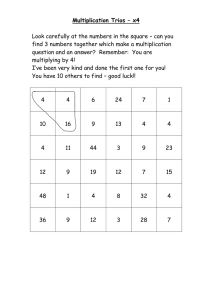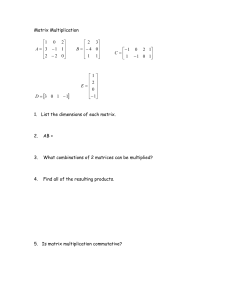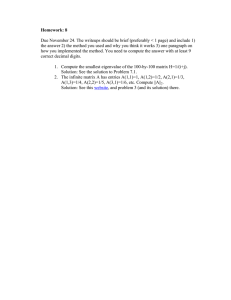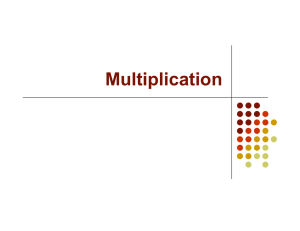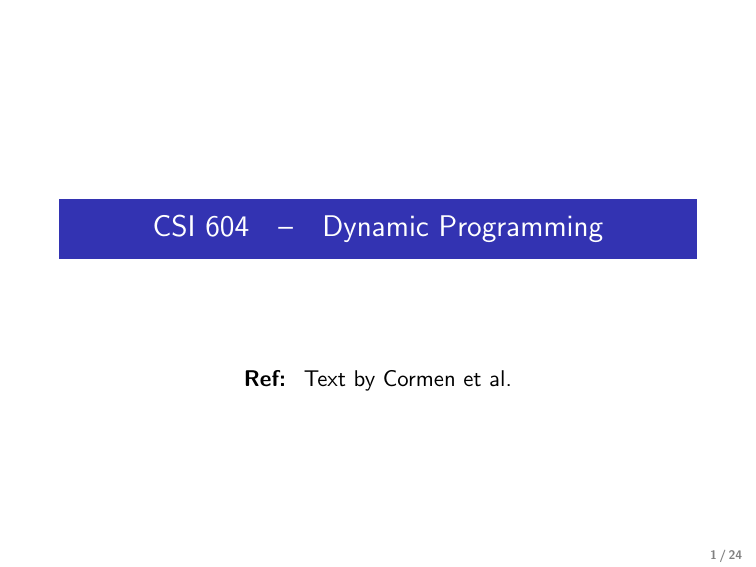
CSI 604 – Dynamic Programming
Ref: Text by Cormen et al.
1 / 24
Dynamic Programming – A Simple Example
Fibonacci Numbers: Recall that F0 = 0, F1 = 1 and
Fn = Fn−1 + Fn−2
for all n ≥ 2.
An “easy” recursive algorithm:
Fibo (n) { /* Assume n >= 0. */
if (n <= 1)
then return n
else return Fibo(n-1) + Fibo(n-2)
}
Recurrence for running time:
T (n) = T (n − 1) + T (n − 2)
for n ≥ 2
with T (0) = c1 and T (1) = c2 for some constants c1 and c2 .
2 / 24
Fibonacci Numbers (continued)
Exercise: Use induction on n to√show that for all n ≥ 3,
T (n) ≥ Φn−2 , where Φ = (1 + 5)/2 > 1.
Observation: The running time of the recursive algorithm is
exponential in n.
Reason for inefficiency: The same value gets computed many
times.
Remedy:
Avoid recomputation of values by saving them in a table and
use them when they are needed.
A key idea of dynamic programming.
3 / 24
Dynamic Programming (continued)
Iterative algorithm: (Running time: O(n))
Note: A[0..n] stores the computed values.
1. A[0] = 0; A[1] = 1
2. for i = 2 to n do
A[i] = A[i-1] + A[i-2]
Matrix-Chain Multiplication:
Matrix Multiplication – Simple Facts:
The matrix product A × B is defined only when
#columns of A = #rows of B.
Let A be a p × q matrix and B be a q × r matrix. The product
A × B can be computed using pqr scalar multiplications.
4 / 24
Matrix-Chain Multiplication (continued)
Matrix multiplication is associative; that is, for any three
matrices A, B and C ,
A × (B × C ) = (A × B) × C .
Note: Matrix product A × B will be denoted by AB.
A Motivating Example: Suppose A, B and C are matrices of
the following sizes:
A: r × 2
B: 2 × r
C: r × 1
We want to compute the product ABC .
5 / 24
Matrix-Chain Multiplication (continued)
Recall:
A: r × 2
B: 2 × r
C: r × 1
Method I: Compute the product ABC as (AB)C .
Computing AB uses 2r 2 multiplications.
(The result is an r × r matrix.)
Computing the product of AB with C uses r 2 multiplications.
(The result is an r × 1 matrix.)
Total number of multiplications = 3r 2 .
6 / 24
Matrix-Chain Multiplication (continued)
Recall:
A: r × 2
B: 2 × r
C: r × 1
Method II: Compute the product ABC as A(BC ).
Computing BC uses 2r multiplications.
(The result is a 2 × 1 matrix.)
Computing the product of A with BC uses 2r multiplications.
(The result is an r × 1 matrix.)
Total number of multiplications = 4r .
Summary:
Methods I and II use 3r 2 and 4r multiplications respectively.
Method II is better.
7 / 24
Matrix-Chain Multiplication (continued)
Note: Each method of evaluation corresponds to fully
parenthesizing the product.
Example: With four matrices A, B, C and D, some ways of fully
parenthesizing the product ABCD are:
((AB)C )D
(AB)(CD)
(A(BC ))D
A(B(CD))
Matrix-Chain Multiplication Problem:
Given: A chain hA1 A2 · · · An i of matrices where Ai is a
pi−1 × pi matrix (1 ≤ i ≤ n).
Required: Fully parenthesize the product A1 A2 · · · An so that
the total number of scalar multiplications used is minimized.
8 / 24
Matrix-Chain Multiplication (continued)
Initial focus: Compute the minimum number of multiplications.
Known Result: The number of ways of fully parenthesizing the
product A1 A2 · · · An is at least
C (2n, n)/(n + 1) = Ω(4n /n3/2 ).
So, exhaustive search is not viable.
Approach: Let M = A1 A2 · · · An . In any optimal solution, the
last step evaluates the product M1 M2 where
M1 = A1 A2 · · · Ak
and M2 = Ak+1 Ak+2 · · · An
for some k in the range 1 to n − 1.
9 / 24
Matrix-Chain Multiplication (continued)
Recall: The last step computes the product M = M1 M2 where
M1 = A1 A2 · · · Ak
and
M2 = Ak+1 Ak+2 · · · An
for some k in the range 1 to n − 1.
Observation: Regardless of the value of k, for the evaluation of
M to be optimal, the evaluations of M1 and M2 must themselves
be done optimally.
What does the observation tell us?
The original problem gives rise to subproblems of
smaller sizes.
To obtain an optimal solution to the original problem,
each subproblem must also be solved optimally.
Save solutions to subproblems to avoid recomputation.
10 / 24
Matrix-Chain Multiplication (continued)
Information to be stored for each subproblem:
Each subproblem consists of a subchain Cij = Ai Ai+1 · · · Aj ,
where 1 ≤ i ≤ j ≤ n. (So, the number of subproblems =
O(n2 ), which is a polynomial.)
Use an n × n array M to store solutions to subproblems; let
M[i, j] store the minimum number of multiplications needed
to evaluate the subchain Cij .
For each i, 1 ≤ i ≤ n, M[i, i] = 0.
We need to consider only the upper triangular part of M,
that is, entries M[i, j] where i ≤ j.
If all entries of M are available, the solution to the problem is
given by M[1, n].
11 / 24
Matrix-Chain Multiplication (continued)
Computing entries of M: Suppose we want to compute M[i, j]
for some i < j.
Consider all possible values k where the subchain
Ai Ai+1 · · · Aj can be split. Thus, i ≤ k ≤ j − 1.
If the split is at k, the following costs are involved:
1
M[i, k] for evaluating the subchain Ai · · · Ak .
2
M[k + 1, j] for evaluating the subchain Ak+1 · · · Aj .
3
Cost pi−1 pk pj to multiply the two matrices resulting from
1 and 2 above.
So, the value of M[i, j] is given by
M[i, j] =
min {M[i, k] + M[k + 1, j] + pi−1 pk pj }
i≤k<j
12 / 24
Matrix-Chain Multiplication (continued)
Recall: The value of M[i, j] is given by
M[i, j] =
min {M[i, k] + M[k + 1, j] + pi−1 pk pj }
i≤k<j
(1)
Organizing the Computation:
Initialization: M[i, i] = 0, 1 ≤ i ≤ n.
To compute M[i, j] using Equation (1), we need to make sure
that all the required entries of M have already been
computed.
Idea: Compute the entries of M in increasing order of the
subscript difference j − i.
13 / 24
Matrix-Chain Multiplication (continued)
Organizing the Computation (continued):
Computing in increasing order of subscript difference:
1
First, compute all entries where the subscript difference is zero;
that is, compute M[i, i], 1 ≤ i ≤ n. (This is trivial since
M[i, i] = 0, 1 ≤ i ≤ n.)
2
Next, compute all entries where the subscript difference is 1;
that is, compute M[i, i + 1], 1 ≤ i ≤ n − 1.
3
Then compute all entries where the subscript difference is 2;
that is, compute M[i, i + 2], 1 ≤ i ≤ n − 2, ..., and so on, up
to subscript difference n − 1.
Now, when we need to compute M[i, j] with j − i = t, we will
have the values of M[i, k] and M[k + 1, j] where the subscript
difference is less than t.
14 / 24
Matrix-Chain Multiplication (continued)
Pseudocode: See Handout 1.1. (A numerical example will be
presented in class.)
Running time: (Step numbers are from Handout 1.1.)
Step 1: O(n).
Step 2:
Steps 2.1.1 and 2.1.2 take O(n) time.
The loop in Step 2.1 executes O(n) times and each iteration
takes O(n) time. So, the time for Step 2.1 is O(n2 ).
The loop in Step 2 executes O(n) times and each iteration
takes O(n2 ) time. So, the time for Step 2 is O(n3 ).
Step 3: O(1) time.
So, the overall running time is O(n3 ).
Space: O(n2 ) due to the n × n matrix M.
15 / 24
Matrix-Chain Multiplication (continued)
Exercise: Modify the pseudocode in Handout 1.1 so that a fully
parenthesized expression is also printed out in addition to the
minimum number of multiplications. The running time should
remain O(n3 ).
Hint: Make each entry of M[i, j] a record containing two fields:
one field is the cost as before and the other field is a value of index
k where an optimal split of the subchain Cij = Ai Ai+1 · · · Aj
occurs.
Fastest known algorithm: O(n log n) due to T. Hu and
M. Shing (SIAM J. Computing, 1982).
16 / 24
Dynamic Programming for a 1-Dimensional Problem
Maximum Subarray Sum (MSS) Problem:
Given a sequence S of numbers hx1 , x2 , . . . , xn i,
a subarray is a contiguous part of S, namely
hxi , xi+1 , . . . , xk i, for some i ≤ k.
A single value is a subarray of length 1.
We will ignore the empty subsequence.
MSS Problem Statement:
Given: A sequence S of n numbers hx1 , x2 , . . . , xn i, some of
which may be negative.
Required: The maximum sum over all subarrays of S.
17 / 24
Maximum Subarray Sum Problem (continued)
Approach:
Subproblem: For each i, find the best subarray sum that
ends at xi , 1 ≤ i ≤ n.
No. of subproblems = n.
Solution to subproblems stored in array B[1 .. n].
Computation Steps:
B[1] = x1 .
To compute B[i + 1] for 1 ≤ i ≤ n − 1:
B[i + 1] = B[i] + xi+1 if B[i] > 0
= xi+1
otherwise.
Solution is the largest value in B.
18 / 24
Maximum Subarray Sum Problem (continued)
Pseudocode: See Handout 1.1.
Running time and space: O(n).
Exercise: Modify the pseudocode in Handout 1.1 so as to print
out the starting and ending indices of the subarray with the
maximum sum. The running time should remain O(n).
19 / 24
Subset Sum Problem: Definition
Definition: A multi-set is one in which some elements may
appear two or more times.
Subset Sum Problem:
Given: A multi-set S = {a1 , a2 , . . . , an } of positive integers and a
positive integer B.
Question: Is there a subset S 0 of S such that the sum of the
elements in S 0 is equal to B?
Note: The Subset Sum problem is NP-complete.
20 / 24
A Dynamic Programming Algorithm for Subset Sum
Approach:
Each subproblem can be specified using two indices
i and j: the subproblem consists of the multi-set {a1 , . . . , ai }
and integer j, where 1 ≤ i ≤ n and 0 ≤ j ≤ B.
Solutions to subproblems are stored in a 2-dimensional
Boolean array T with n rows (numbered 1 to n) and B + 1
columns (numbered 0 through B).
Significance of entry T [i, j]:
T [i, j]
=
true
=
false
if there is a subset of {a1 , . . . , ai }
with sum = j and
otherwise.
21 / 24
Algorithm for Subset Sum (continued)
After computing all entries of T , the Boolean value T [n, B]
tells us whether there is a solution to the problem.
Computation Steps:
All entries in the first row of T can be computed easily:
T [1, j] = true
if j = 0 or j = a1
= false otherwise.
To compute the entries in row i for 2 ≤ i ≤ n:
T [i, j]
=
true
=
false
if T [i − 1, j] = true or
T [i − 1, j − ai ] = true
otherwise.
Pseudocode: See Handout 1.1. (A numerical example will be
presented in class.)
22 / 24
Algorithm for Subset Sum (continued)
Running time:
There are O(nB) entries in array T .
The value of each entry can be computed in O(1) time.
So, the overall running time is O(nB).
The size of input is O(n log a + log B), where a is the
largest integer in S.
So, the running time is not polynomial in
the size of the input.
This is a pseudo-polynomial time algorithm.
23 / 24
Algorithm for Subset Sum (continued)
Space:
Space is also O(nB) due to the array T .
Can be reduced to O(B) since we need to keep
only two rows of T .
√
Fastest known algorithm: O( n (log n)c B) due to Koiliaris and
Xu, July 2015. (Here c is a constant.)
24 / 24
